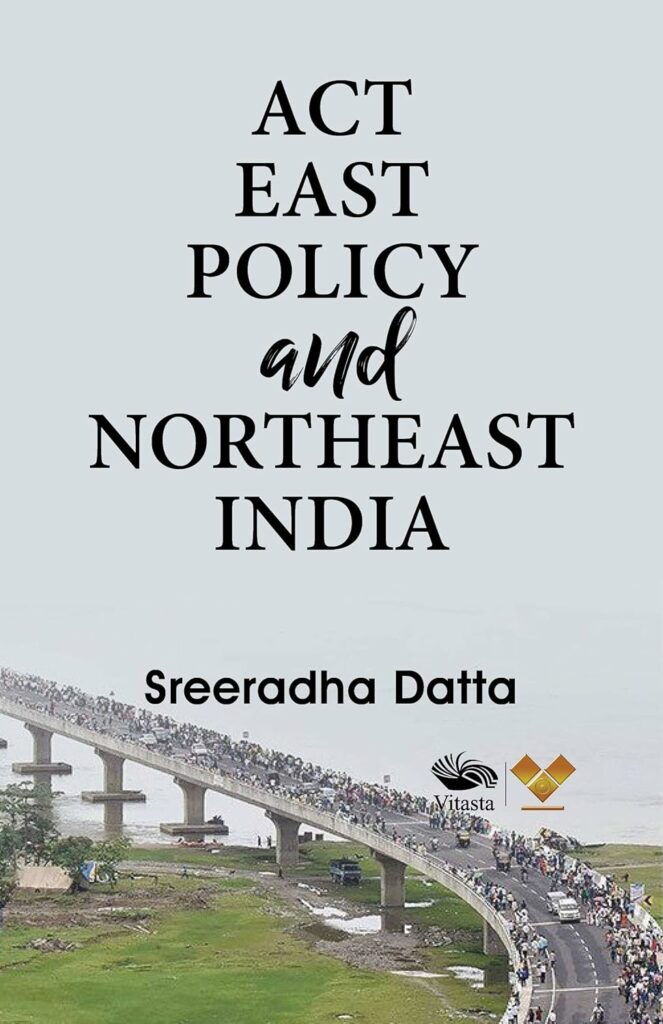Sreeradha Dutta’s analysis shows that complex interdependence requires a more collective, coordinated, and coherent approach to infrastructure development, governance frameworks, and respectable foreign policy policies.

Sreeradha Dutta’s “Act East Policy and Northeast India” offers a comprehensive analysis of India’s strategic initiative aimed at enhancing connectivity and cooperation in the Northeast region. The book contextualizes the Act East Policy within a broader framework of regional development, security, and economic growth, emphasizing the unique challenges and opportunities that the Northeastern states face.
Dutta starts with contextualizing the Northeast’s development, where she points out that for years security has been the defining concern for the region. This focus has especially led to the suppression of political will to seek a positive change, thereby, developing a propensity towards neglect and underdevelopment. The author postulates that when there is a focus on the border infrastructure of South Asia the key to the official practice of sub-regionalism is feasible, in consideration of the fact that SAARC regionalism has a marginal impact. In recent years, the current government has the political intent to aim at equally enlarging the political vertex of the region in the Northeast, mainly with the new infrastructural infrastructures to build up the Northeast region as a bridge from Bangladesh to Myanmar and South Asia to Southeast Asia.
Sreeradha Dutta starts by contextualizing the Northeast’s development, where she points out that for years security has been the defining concern for the region.
However, outbreaks of ethnopolitics and bitter feelings towards encroachment by other persons from the outside world have made the region unfriendly to the much-needed capitalized investments. The Northeastern Region Report 2020 finds lack of infrastructure to be the single largest impediment to growth across all sectors of transportation—road, rail, air, and inland waterways—as well as power supply and telecommunications. Until industries based on local resources are developed, particularly in the small and medium-scale sectors, Northeast India remains far from becoming a significant source of exports under the Act East Policy. Dutta has highlighted two major categories of concerns that she feels should be given some thought. First, domestic policies must be aware of the perceived historical neglect; any negative new policy development efforts could be set back. Second, the intention of its foreign policy to neighbouring countries is also being given a signal message.

The book mentions that even as India looks to expand bilateral cooperation with its neighbours, it does not want the issue of Illegal immigrants to a country like Bangladesh to affect its bilateral ties.
The author notes that it is naive to reduce domestic policies’ effectiveness to only foreign policymaking. For instance, India’s attempts to manage diplomatic relations were evident when then Foreign Secretary Harsh Vardhan Shringla met with Bangladesh’s Prime Minister Sheikh Hasina regarding the Citizenship Amendment Act (CAA).
Implementation of infrastructure is significant in linking Northeastern states with the rest of Indian States. However, the realization of a network of transportation corridors is hindered by numerous issues, such as an imbalance of hardware and software and the fact that planning remains unfinished at present. The CUTS Policy Brief indicates that sub-national road conditions will hardly facilitate seamless traffic movement within the BBIN (Bangladesh-Bhutan-India-Nepal) framework. It identified shortcomings in cross-border infrastructure and infrastructure-related areas such as testing laboratories, warehousing, cold storage, and parking which are required to be corrected if cross-border trade is to fulfil its potential.
The Northeastern Region Report 2020 finds lack of infrastructure to be the single largest impediment to growth across all sectors of transportation—road, rail, air, and inland waterways—as well as power supply and telecommunications.
Dutta outlines three primary functions of borders: first, they exclude territorial sovereignty; second, they prescribe how control and protection are to be handled; third, they enable contact and cooperation. Thus, while a certain volume of border trade is still in evidence, the major portion of it takes place through barter channels because the goods on formal lists of exports and imports are not in great demand following India’s action of reducing many tariffs on many items. Decisions on import duties made in an unorganized manner have affected cross flows of agricultural products. Moreover, there are difficulties remaining in the banking sphere; Until 2015 barter transactions were prohibited which led to reduced transaction turnover.
Many small and medium businesses on both sides of the border struggle to meet regulatory criteria and norms necessary for formal trade. Despite the establishment of Integrated Check Posts (ICPs), many remain non-operational; goods terminals are not functional, and new land bridges facilitating two-way trade are still under construction. Such factors as the movement of human persons have raised much concern especially when the passenger terminals began to open at the ICPs.
The fact that different regions do not have harmonized acceptable quality standards remains a major challenge to the growth of trade. Claims that were made include that quality assurance is sometimes used by customs officials as a way of distorting trade flows.
Sreeradha Dutta outlines three primary functions of borders: first, they exclude territorial sovereignty; second, they prescribe how control and protection are to be handled; third, they enable contact and cooperation.
Dutta lists two main reasons why the next decade could be referred to as the ‘Northeastern Decade.’ First and foremost, the region strongly requires efficient utilization and management of Northeast India’s assets. Second, achieving even greater regional integration into mainstream India and other neighbouring countries also offers a way of integrating the region for development.
In conclusion, Act East Policy and Northeast India provide valuable insights into the complexities surrounding India’s Northeast region within the context of its broader geopolitical strategy. To this effect, Dutta’s analysis shows that complex interdependence requires a more collective, coordinated, and coherent approach to infrastructure development, governance frameworks, and respectable foreign policy policies. The book serves as an essential resource for policymakers and scholars alike, calling for urgent action to address historical grievances while leveraging new opportunities presented by the Act East Policy. These efforts have defined Dutta’s vision to develop the Northeast region as a gateway to both South Asia and Southeast Asia besides establishing it as a prosperous belt of business and cultural corridor.
(Parag is a final-year student in global affairs at OP Jindal Global University with a keen interest in sports diplomacy and Indian politics. Views expressed are the author’s own)
Book: Act East Policy and Northeast India
Authors: Sreeradha Datta
Publishers: Vitasta Publishing Private Limited
Price: ₹ 558 (Hardcover)
SW Ratings: ****
Parag Gilada is a Mukherjee Fellow who has recently graduated from the Jindal School of International Affairs with a keen interest in Sports Diplomacy. Views expressed are the author’s own.
